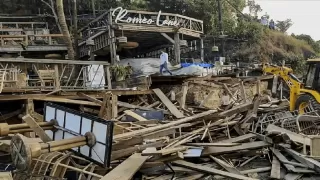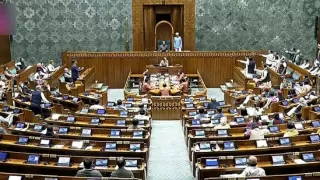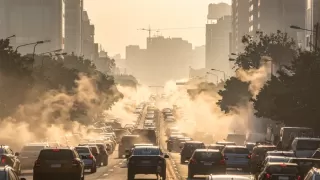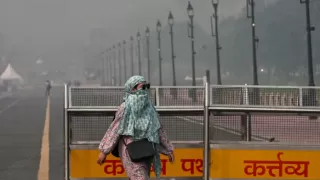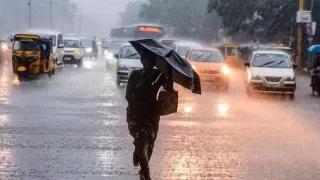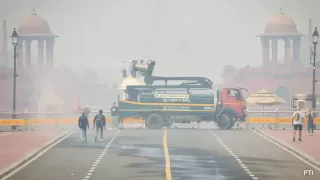A powerful 5.7-magnitude earthquake shook large parts of Bangladesh on Friday morning, sending shockwaves across eastern India and prompting people to rush out of homes, offices, and crowded marketplaces. The tremors, which struck shortly after 10 am IST, were strong enough to be felt in Kolkata and several districts of West Bengal, leaving residents alarmed as ceiling fans, window frames, and light fixtures swayed visibly. Early reports from Bangladesh confirmed that the epicentre was located close to Narsingdi, not far from Dhaka, where the quake caused significant damage.
Authorities in Bangladesh have confirmed multiple casualties, with several deaths attributed to collapsing structures in densely populated neighbourhoods of Dhaka. Residents described moments of panic as portions of old roofs, boundary walls, and fragile building railings gave way, injuring bystanders and causing widespread chaos. Meanwhile, in India, no serious damage has been reported so far, though thousands felt the tremors distinctly across West Bengal, Meghalaya, Tripura, Mizoram, and parts of the Northeast.
The quake has reignited concerns about seismic vulnerability in the region, which sits atop one of the most active tectonic zones in Asia. Experts note that even moderate quakes can cause disproportionate damage due to high population density, rapid urban development, and aging infrastructure. As officials assess the aftermath of Friday’s tremors, citizens in both countries are being urged to stay alert and follow safety advisories in case of aftershocks.
Epicentre and Seismic Details of the Bangladesh Earthquake
According to initial geological assessments, the epicentre of the 5.7-magnitude earthquake lay roughly 14 kilometers from Narsingdi in central Bangladesh. The shallow depth at which the quake originated was a key reason it was felt strongly across the region. Shallow earthquakes tend to produce more intense shaking because seismic waves travel a shorter distance before reaching the surface, increasing the impact on buildings and infrastructure.
Residents across Bangladesh reported sudden vibrations that lasted several seconds, causing many to flee outside in fear. In Dhaka, the tremors were forceful enough to cause cracks in older buildings and dislodge parts of balconies and parapet walls. Emergency services reported receiving multiple distress calls within minutes of the quake, particularly from areas with high-rise residential blocks and older commercial hubs.
The National Center for Seismology in India confirmed that the quake occurred at 10:08 am IST and was strong enough to be felt across state borders. While Kolkata and its suburban regions experienced mild but noticeable shaking, experts emphasized that the city's soft soil conditions allow tremors from distant quakes to travel efficiently, making such events more perceptible to residents.
Casualties and Damage Reported in Bangladesh
Early reports from Bangladesh indicated that at least six individuals lost their lives due to structural collapses triggered by the earthquake. Three deaths occurred when portions of a roof and a boundary wall crumbled in densely populated areas. In separate incidents, falling concrete railings injured pedestrians, proving fatal for three individuals who were caught beneath the debris during the sudden tremors.
Authorities in Dhaka are conducting rapid inspections of damaged structures to assess further risks. Old buildings in metropolitan Bangladesh are known to be particularly vulnerable due to inadequate retrofitting and limited adherence to modern construction standards. Rescue teams were deployed shortly after the quake, working to secure hazardous spots, clear debris, and assist residents whose homes were affected by the shaking.
With Friday’s events highlighting structural weaknesses, urban planners and seismic experts have renewed their calls for stricter building codes, particularly in high-risk zones. Bangladesh lies close to several tectonic boundaries, making periodic earthquake activity a natural but potentially dangerous occurrence without adequate preparedness.
Tremors Felt Across Kolkata and Eastern India
In Kolkata, many residents reported feeling sudden, mild tremors that caused household items to rattle and hanging objects to sway noticeably. Office workers shared accounts of evacuating buildings briefly as a precaution, while residents in high-rise apartments described several seconds of shaking. Social media platforms quickly filled with videos showing swaying ceiling fans, moving curtains, and startled reactions from people who rushed outdoors.
Districts such as Cooch Behar, Dakshin Dinajpur, and Uttar Dinajpur also reported noticeable tremors. In parts of Meghalaya, Tripura, and Mizoram, locals experienced brief shaking but no structural damage was recorded. Disaster management teams were placed on standby across the region to respond to any emerging reports.
Experts noted that Kolkata’s seismic sensitivity is heightened due to soft alluvial soil conditions that amplify waves from distant quakes. Although Friday’s tremors were relatively mild in India, authorities urged residents to remain vigilant, particularly in older buildings that may have existing structural weaknesses.
Public Reaction and Widespread Social Media Response
The moments following the quake saw a flood of posts, images, and videos from residents across eastern India and Bangladesh. People shared visuals of homes, offices, and public spaces reacting to the tremors. Many captured footage of ceiling fans swinging back and forth, furniture shaking subtly, and crowds gathering outside buildings as a safety measure.
While officials cautioned citizens not to panic, the widespread reaction highlighted the region's anxiety regarding seismic activity, especially following past devastating quakes in South Asia. Public response also served a crucial role in helping authorities pinpoint the spread of tremor intensity through crowdsourced reports.
Schools, offices, and commercial centers temporarily paused activities in some areas as people waited for official updates. No major disruptions were reported, but several institutions conducted precautionary checks to ensure structural safety before resuming operations.
Pakistan Also Hit by Separate Earthquake
Just a day prior, a separate 3.9-magnitude earthquake struck Pakistan, as confirmed by regional monitoring agencies. The tremor, occurring at a shallow depth of 10 kilometers, was also characteristic of seismic activity known to produce strong surface sensations despite lower magnitudes.
Shallow earthquakes are particularly concerning because they can cause more noticeable ground movement and pose greater risks in areas where buildings lack modern reinforcements. Pakistan lies in the same active tectonic belt that stretches across Afghanistan, northern India, and parts of Nepal—one of the most seismically volatile regions in the world.
Experts warn that consistent seismic events across South Asia serve as reminders of the region’s vulnerability and the importance of earthquake-resistant construction practices. Combined with population density and varied building standards, even moderate tremors can lead to significant disruption.
India-Bangladesh-Pakistan: A Highly Seismic Region
The Indian subcontinent sits at the intersection of major tectonic plates, making it one of the world’s most active earthquake zones. The ongoing collision between the Indian and Eurasian plates creates immense geological pressure, leading to frequent quakes across Afghanistan, Pakistan, northern India, Nepal, Bhutan, and Bangladesh.
Geologists have long emphasized that the region’s geography makes periodic tremors unavoidable. However, the extent of damage depends on preparedness, construction quality, and public awareness. Urban centers with dense populations and aging infrastructure face heightened risk even from moderate quakes like Friday’s event.
With the latest tremors fresh on people’s minds, disaster agencies in both India and Bangladesh continue to monitor aftershock possibilities. Public advisories encourage residents to stay informed, avoid unsafe buildings, and follow recommended safety precautions during seismic events.
Conclusion
The 5.7-magnitude earthquake that struck Bangladesh has left a profound impact across the region, with casualties reported in Dhaka and tremors felt widely across eastern India. While India escaped major damage, the event serves as a stark reminder of the seismic vulnerabilities shared by South Asian nations. Authorities on both sides of the border are now assessing structural safety, preparing for potential aftershocks, and calling for stronger adherence to building guidelines.
The quake’s impact, social media reaction, and subsequent discussions have once again highlighted the need for improved disaster readiness. As investigations continue and safety teams conduct inspections, residents are urged to stay vigilant and prioritize safety in the wake of this significant seismic event.
Also Read: Al-Falah Group Chairman’s Mhow Property Faces Legal Notice






